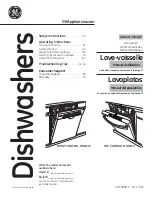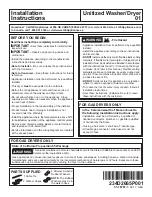
8
ATTENTION:
Always unplug the appliance when cleaning it and
when performing maintenance work. Do not use flammable liquids
to clean the machine.
CLEANING THE DISHWASHER
Any marks on the inside of the appliance may be
removed using a cloth dampened with water and
a little vinegar.
The external surfaces of the machine and the con-
trol panel can be cleaned using a non-abrasive cloth
which has been dampened with water. Do not use
solvents or abrasive products.
PREVENTING UNPLEASANT ODOURS
Always keep the door of the appliance ajar in order to avoid moisture
from forming and being trapped inside the machine.
Clean the seals around the door and detergent dispensers regularly
using a damp sponge. This will avoid food becoming trapped in the
seals, which is the main cause behind the formation of unpleasant
odours.
CHEKING THE WATER SUPPLY HOSE
Check the inlet hose regularly for brittleness and cracks. If damaged,
replace it by a new hose available through our After-Sales Service or
your specialist dealer. Depending on the hose type:
If the inlet hose has a transparent coating, periodically check if the
colour intensifies locally. If yes, the hose may have a leak and should
be replaced.
For water stop hoses: check the small safety valve inspection window
(see arrow). If it is red, the water stop function was triggered, and the
hose must be replaced by a new one.
For unscrewing this hose, press the release button while unscrewing
the hose.
CLEANING THE WATER INLET HOSE
If the water hoses are new or have not been used for an extended
period of time, let the water run to make sure it is clear and free of
impurities before performing the necessary connections. If this
precaution is not taken, the water inlet could become blocked and
damage the dishwasher.
CLEANING THE FILTER ASSEMBLY
Regularly clean the filter assembly so that the filters do not clog and
that the waste water flows away correctly.
The filter assembly consists of three filters which remove food residu-
es from the washing water and then recirculate the water: to obtain
the best washing results, you need to keep them clean.
The dishwasher must not be used without filters or if the filter is
loose.
CLEANING THE SPRAY ARMS
On occasions, food residue may be-
come encrusted onto the spray arms
and block the holes used to spray the
water. It is therefore recommended
that you check the arms from time
to time and clean them with a small
non-metallic brush.
To remove the upper spray arm, turn
the plastic locking ring in an
anti-clockwise direction. The upper
spray arm should be replaced so that
the side with the greater number of holes is facing upwards.
The lower spray arm may be remo-
ved by pulling it upwards.
CARE AND MAINTENANCE
1 2
3 4
After several washes, check the filter assembly and if necessary clean
it thoroughly under running water, using a non-metallic brush and
following the instructions below:
1. Turn the cylindrical filter
A
in an anti-clockwise direction and pull
it out
(Fig 1)
.
2. Remove the cup filter
B
by exerting a slight pressure on the side
flaps
(Fig 2)
.
3. Slide out the stainless-steel plate filter
C
(Fig 3)
.
4. Inspect the trap and remove any food residues.
NEVER REMOVE
the wash-cycle pump protection (black detail) (
Fig 4)
.
After cleaning the filters, re-place the filter assembly and fix it in
position correctly; this is essential for maintaining the efficient
operation of the dishwasher.
A
A
B
C
Содержание WSIP 4O33 PFE
Страница 12: ...12 400011264245B 07 2018 as Xerox Fabriano ...






























